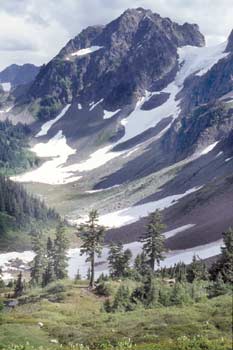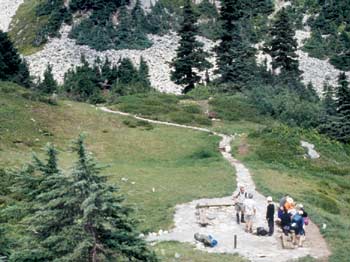Chapter 1—The Context for Wilderness Restoration
This chapter includes three sections. The first section provides a historical context for wilderness restoration projects. The second section explains the relationship between wilderness impacts and ecological processes. The third section is an overview of the ecological concepts that influence the success of restoration projects.
1.1 Wilderness Restoration in the Past, Present, and FutureThe Wilderness Act directs agencies to protect and manage wilderness "so as to preserve its natural conditions,"ensuring that wilderness "generally appears to have been affected primarily by the forces of nature, with the imprint of man's work substantially unnoticeable." Although the Wilderness Act does not specifically mention restoration, increasingly managers are turning to restoration to preserve wilderness character. Heavy scars on the land—whether from past practices or ongoing uses—compromise the goals of the Wilderness Act. Restoration (figures 1-1a and 1b) is one way to reduce the scars. Interest in wilderness restoration is at an all-time high.

Figure 1-1a-Cascade Pass in North Cascades National Park, WA.

Figure 1-1b-Since the 1970s and continuing to this day,
North Cascades National
Park has worked to restore meadows
at Cascade Pass using native plants grown
in the park's greenhouse.
It is difficult to trace the true beginnings of wilderness restoration. Recent related efforts consist of attempts to reforest areas of timber harvest, to rehabilitate overgrazed rangelands, and to revegetate roadcuts and other disturbances in parks. In the 1960s, research was conducted on maintaining or restoring vegetation at developed campgrounds (Wagar 1965, Jollif 1969).
In wilderness, most efforts can be traced to the Pacific Northwest and several projects undertaken by the Forest Service and the U.S. Department of the Interior National Park Service, based on the research and recommendations of Dale Thornburgh, a forestry professor at Humboldt State University (1962, 1970). These projects were undertaken in 1970 and shortly thereafter-first in the Glacier Peak Wilderness (figures 1-2a and 2b) and North Cascades National Park and then at Mt. Rainier and Olympic National Parks. By the mid-1970s, wilderness restoration projects had spread to a number of other national parks, such as Rocky Mountain and Yosemite.

Figure 1-2a-Image Lake in the Glacier Peak
Wilderness, WA, wasn't always this
scenic.

Figure 1-2b-By the 1960s unregulated recreational
stock use
had
severely degraded
meadows and forested campsites.
In
response, the Forest Service closed the
lake basin to all
stock
use and overnight backpacker use and began restoration.
The
lush meadows responded quickly to the elimination of stock
use,
but the
drier shaded campsites have responded slowly to treatments.
Much of the credit for the blossoming of wilderness restoration in the Pacific Northwest goes to volunteer biologists Joe and Margaret Miller (figure 1-3). In 1970 they were given the task of carrying out Thornburgh's suggestions. They started with a few of his ideas, and developed and tried many more of their own. Concerned managers from neighboring areas adopted the Millers' ideas and developed others.

Figure 1-3-Volunteer biologists Joe and Margaret Miller
deserve much of the
credit for the blossoming of wilderness
restoration in the Pacific Northwest.
[This photograph
was digitally altered to remove distracting elements.]
Many revegetation efforts in Pacific Northwest national parks were documented. It is possible to learn from the early progress of the Millers (Miller and Miller 1979) and other practitioners at North Cascades (Lester 1989), Mt. Rainier (Dalle-Molle 1977), and Olympic National Parks (Scott 1977).
Restoration appears to have become one of the jobs of wilderness management. The number of wilderness rangers with rudimentary site restoration skills is increasing rapidly. Many national parks now have greenhouses or nurseries. Restoration skills are being taught both by agencies and by outside specialists, such as the Student Conservation Association.
The most important lessons of site restoration have been:
- Practical
methods for restoring damaged sites
- Improved perspectives on restoration's role in wilderness management
1.1.2a Practical Methods of Restoration
The initial restoration projects in the Pacific Northwest usually involved transplanting plugs of vegetation from neighboring areas. This technique, while simple and generally successful, affects adjacent areas. It is impossible to find much material for revegetation without causing substantial impacts elsewhere. This problem has been alleviated by offsite propagation and improved methods of revegetation from seeding.
At North Cascades National Park, the Millers pioneered the technique of removing plant plugs from the field, dividing and growing them at low-elevation greenhouses, and transporting plants back to the damaged site for planting. This technique was effective, but costly and time consuming. Moreover, it had the added disadvantage of reducing the genetic diversity of the population because all individuals were clones of a few original plants.
Some of these problems were overcome when workers discovered effective means of propagating plants from seed in the greenhouse. Now it is possible to collect seed in the field, germinate these seeds, grow plants in the greenhouse, and then transplant the seedlings to the field. The key to successful germination of subalpine plants includes sunlight, high humidity around the seed, and high soil temperatures (Lester 1989). Through trial and error, workers have come up with more effective means of propagating difficult species, such as the heathers.
In some parts of the country, such as the Colorado Rocky Mountains, rangers have had considerable success using direct seeding to revegetate damaged sites. However, in the Pacific Northwest, seeding has been used effectively only in recent years. Through trial and error, managers found that seeds would germinate in abundance if they were kept warm and moist. The key was to cover the site with polyethylene sheeting (Visqueen). Difficulties still remain, such as the cost of collecting seed. Generally, seeding will be the most cost-effective means of revegetating damaged sites.
Progress also has been made in understanding the importance of mulches, which help retain moisture and prevent seeds from blowing or washing away. While native mulch is the best option, commercial mulches are often a more feasible alternative. Initially, jute netting was the most commonly used mulch. However, jute often decomposed too slowly, was too obtrusive, and entangled emerging plants. Jute is still used, but practitioners now use a wider variety of mulches that can be tailored to individual needs.
Most of these advances in technique were made through trial and error. A few individuals experimented with different techniques, monitored the effectiveness of each technique, and communicated what they had learned to others. It is imperative that all of us continue this process. This means we must experiment, document, monitor, and communicate our successes and our failures.
1.1.2b How Restoration Fits With Wilderness Management
Any time visitor use is shifted, impacts will shift as well. New impacts are created, while scars from old impacts may remain. These scars should be healed as quickly as possible. For example, restoration should be an integral part of trail relocation programs. Eroded trail segments frequently are abandoned without rehabilitation when trails are relocated. Restoration should be part of the original trail reconstruction plan. Building a trail may leave a substantial amount of soil and plant material that can be used to revegetate old tread (figures 1-4a and 4b). The key is to time the work and to have resources available to use the soil and plant materials as they become available.


Figures 1-4a and 4b-If the vegetation type matches,
plugs of sod salvaged during
trail relocation (top)
can be
used to restore (bottom) an abandoned section
of trail.
In many wildernesses, camping is prohibited near lakeshores, where the impacts of past use are pronounced. This prohibition often has been ineffective and managers may have expended little effort trying to enforce it. If management is serious about a lakeshore setback, restoration should be part of the program. Because the impacts of visitors will be extended into new areas farther from the lakeshore, it is important to restore at least some of the lakeshore. Restoration generally will require keeping all use (not just camping) off the restoration sites for a substantial period. One way of proceeding might be to fence off 20 percent of the lakeshore until that area has been restored and then move to the next 20 percent of the lakeshore. It might take 100 years to restore the lakeshore, but at least restoration could occur.
As we become more aware of the decades required for restoration and the difficult odds that must be overcome, some workers are becoming more conservative. Increasingly, they decide that it may be better to allow an impacted area to continue being used than to move that impact elsewhere while attempting to restore the old site. Or they decide to restore the fringes of damaged sites (figures 1-5a and 5b), reducing the size of the area being damaged without moving use elsewhere.

Figure
1-5a-The margin of this campsite was revegetated with
locally native plants grown
in a greenhouse. The flat portions of
the
site remain open for camping at Little
Caroline Lakes
in the Alpine Lakes Wilderness, WA.

Figure 1-5b- This trail at Lake Mary was narrowed using
rocks so the margins
could be restored.
Restoration should be undertaken only when adequate resources are available and success is likely. The causes of the impacts must be identified and a feasible means of keeping the impacts from recurring elsewhere must be laid out. Preventing impacts usually involves a variety of visitor management techniques, from access restrictions to visitor education. Site restoration becomes just one technique among a suite of techniques needed to deal with impacts.
We do not have a crystal ball allowing us to predict the future. However, if current trends continue, the future of site restoration in wilderness will bring:
- More
specific skill development
- An increase in holistic planning
The blossoming of restoration ecology as a discipline, along with the acceleration of wilderness restoration, should lead to dramatically improved restoration skills. The rate of improvement will depend primarily on the rigor that goes into experimentation and documentation of restoration trials. Everyone can contribute to the long-term success of restoration techniques by documenting their restoration projects and communicating their results.
Often, nurseries and greenhouses are being used as restoration tools. Techniques for propagating species that are difficult to grow are being developed. More commercial nurseries are taking an interest in native species and more volunteer organizations are available to help.
A good plan doesn't guarantee a good project, but it can help. Plans are likely to improve in comprehensiveness, scale, and integration. In the past, most restoration plans dealt primarily with the specific techniques that were used to get plants growing on the site again. Increasingly, we are seeing plans that start with goals, assess constraints, set targets, and monitor success in relation to these targets. Such programs are more likely to be successful and are more likely to help us learn from the failures that inevitably occur.
In the future, planners are more likely to:
- Consider one specific site in the context of larger areas or even
an entire wilderness.
- Link site restoration to other management actions
needed to keep problems from recurring or simply being shifted elsewhere.
- Recognize the long timeframes that generally are required, such as the more than 20 years needed to restore Cascade Pass (figures 1-6a and 6b) in the North Cascades.


Figures 1-6a and 6b-These photos, taken 28 years apart,
show the
effects of
restoration at Cascade Pass in North Cascades National Park, WA.
- Consider issues of genetics, which were given little thought a decade or two ago.
Finally, future plans will do a better job of integrating people and ecosystem management. Research on visitors and visitor management is as important to success as research on plant propagation and site management. An excellent example of planning that integrates people and ecosystem management is the work done to rehabilitate Paradise Meadows at Mt. Rainier (Rochefort and Gibbons 1992). Ecosystem management is a recent buzzword, but the interdisciplinary approach it implies is critical to the success of wilderness restoration.

